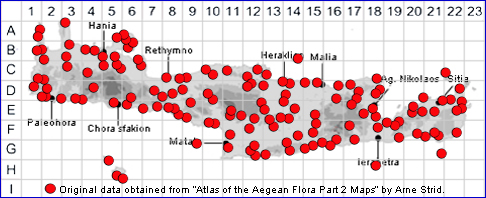
SPECIES DESCRIPTION
PHAGNALON RUPESTRE
Including:- Subsp. rupestre and Subsp. graecum which have often been
regarded as separate species, but the distinguishing features (mainly shape of the
outer phyllaries) are subtle and inconsistent.1)
1) Arne Strid "Atlas of the Aegean Flora". Book 1 2016
Family:- COMPOSITAE
Common Names:- Shrubby cudweed
Synonyms:- Phagnalon rupestre ssp. graecum.
Meaning:- Phagnalon. Meaning unknown.
Rupestre (L) Of rock, living in rocky places.
Graecum (L) Greek, Grecian.
General description:- Dwarf shrub up to 30 cm.
Stems:-
1) Erect to ascending, white-felted.
Leaves:-
1) 1·5-2·5 cm, oblanceolate to obovate, densely lanate beneath, glabrescent or with
occasional arachnoid hairs above, erose to remotely erose-dentate; margin
somewhat revolute.
Flowers:-
1) Capitula solitary, long-stalked, yellowish, oblong to campanulate, 8-15 mm.
2) Involucral bracts:
a) outer, narrowly triangular to lanceolate, acute, brownish.
b) inner bracts linear-lanceolate, subacute, entire.
Fruit:-
1) Achenes, cylindrical, feathery,
Key features:-
1) Leaves oblanceolate to obovate; margin irregularly sinuate-dentate or strongly
erose.
Habitat:- Rocky slopes with open dry shrubby vegetation, cliffs, stone walls, olive
groves. 0-1100 m.
Distribution:- Widespread and common throughout the Mediterranean. Widespread
and common on Crete.
Subsp. rupestre and Subsp. graecum The former is widespread in the
Mediterranean region, whereas the latter has its centre of distribution in the Aegean
area, extending to W & S Anatolia and Cyprus with scattered occurrences also in
the Adriatic region and maybe S Italy and Malta.1)
1) Arne Strid "Atlas of the Aegean Flora". Book 1 2016
Flowering time:- Mar-June.
Photos by:- Steve Lenton
